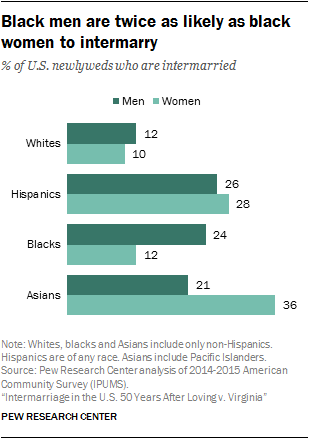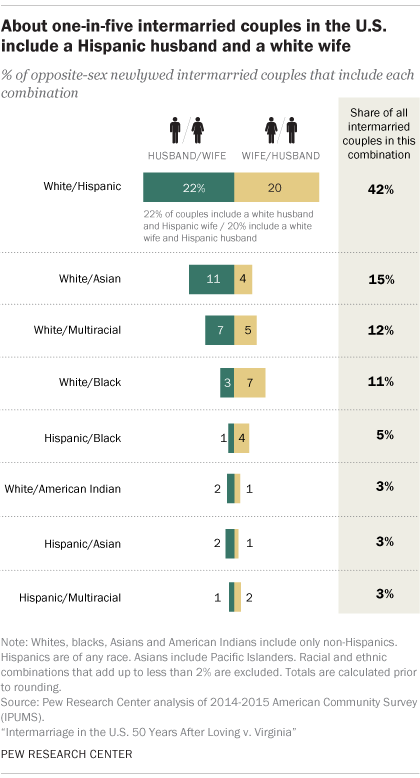pov: (1) 在美国出生的亚洲人中,有46%的人有不同种族或族裔的配偶 (46% among the U.S. born Asians have a spouse of a different race or ethnicity). (Fig.1) (2) (36%亚女, 24%黑男)与外族婚 (Fig. 2) Ref.--- https://www.pewsocialtrends.org/2017/05/18/1-trends-and-patterns-in-intermarriage/ (1) Intermarriage varies by race and ethnicity Fig. 1 Fig. 1
Overall increases in intermarriage have been fueled in part by rising intermarriage rates among black newlyweds and among white newlyweds. The share of recently married blacks with a spouse of a different race or ethnicity has more than tripled, from 5% in 1980 to 18% in 2015. Among recently married whites, rates have more than doubled, from 4% up to 11%. At the same time, intermarriage has ticked down among recently married Asians and remained more or less stable among Hispanic newlyweds. Even though intermarriage has not been increasing for these two groups, they remain far more likely than black or white newlyweds to marry someone of a different race or ethnicity. About three-in-ten Asian newlyweds (29%) have a spouse of a different race or ethnicity. The same is true of 27% of Hispanics. For newly married Hispanics and Asians, the likelihood of intermarriage is closely related to whether they were born in the U.S. or abroad. Among the half of Hispanic newlyweds who are immigrants, 15% married a non-Hispanic. In comparison, 39% of the U.S. born did so. The pattern is similar among Asian newlyweds, three-fourths of whom are immigrants. While 24% of foreign-born Asian newlyweds have a spouse of a different race or ethnicity, this share rises to 46% among the U.S. born. (2) For blacks and Asians, big gender gaps in intermarriageWhile there is no overall gender difference in intermarriage among newlyweds, starkly different gender patterns emerge for some major racial and ethnic groups.  Fig.2 Fig.2
One of the most dramatic patterns occurs among black newlyweds: Black men are twice as likely as black women to have a spouse of a different race or ethnicity (24% vs. 12%). This gender gap has been a long-standing one – in 1980, 8% of recently married black men and 3% of their female counterparts were married to someone of a different race or ethnicity. A significant gender gap in intermarriage is apparent among Asian newlyweds as well, though the gap runs in the opposite direction: Just over one-third (36%) of Asian newlywed women have a spouse of a different race or ethnicity, while 21% of Asian newlywed men do. A substantial gender gap in intermarriage was also present in 1980, when 39% of newly married Asian women and 26% of their male counterparts were married to someone of a different race or ethnicity. Among Asian newlyweds, these gender differences exist for both immigrants (15% men, 31% women) and the U.S. born (38% men, 54% women). While the gender gap among Asian immigrants has remained relatively stable, the gap among the U.S. born has widened substantially since 1980, when intermarriage stood at 46% among newlywed Asian men and 49% among newlywed Asian women. Among white newlyweds, there is no notable gender gap in intermarriage – 12% of men and 10% of women had married someone of a different race or ethnicity in 2015. The same was true in 1980, when 4% of recently married men and 4% of recently married women had intermarried. As is the case among whites, intermarriage is about equally common for newlywed Hispanic men and women. In 2015, 26% of recently married Hispanic men were married to a non-Hispanic, as were 28% of their female counterparts. These intermarriage rates have changed little since 1980. (3) The largest share of intermarried couples include one Hispanic and one white spouse While the bulk of this report focuses on patterns of intermarriage among all newly married individuals, shifting the analysis to the racial and ethnic composition of intermarried newlywed couples shows that the most prevalent form of intermarriage involves one Hispanic and one white spouse (42%). While this share is relatively high, it marks a decline from 1980, when more than half (56%) of all intermarried couples included one Hispanic and one white person. While the bulk of this report focuses on patterns of intermarriage among all newly married individuals, shifting the analysis to the racial and ethnic composition of intermarried newlywed couples shows that the most prevalent form of intermarriage involves one Hispanic and one white spouse (42%). While this share is relatively high, it marks a decline from 1980, when more than half (56%) of all intermarried couples included one Hispanic and one white person.
The next most prevalent couple type in 2015 among those who were intermarried included one Asian and one white spouse (15%). Couples including one black and one white spouse accounted for about one-in-ten (11%) intermarried couples in 2015, a share that has held more or less steady since 1980. That intermarriage patterns vary by gender becomes apparent when looking at a more detailed profile of intermarried couples that identifies the race or ethnicity of the husband separately from the race or ethnicity of the wife. A similar share of intermarried couples involve a white man and a Hispanic woman (22%) as involve a white woman and a Hispanic man (20%). However, more notable gender differences emerge for some of the other couple profiles. For instance, while 11% of all intermarried couples involve a white man and an Asian woman, just 4% of couples include a white woman and an Asian man. And while about 7% of intermarried couples include a black man and a white woman, only 3% include a black woman and a white man. |